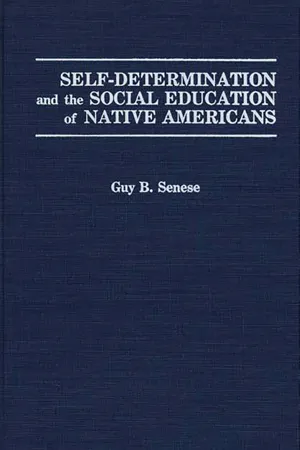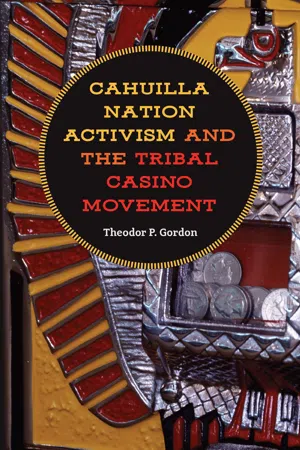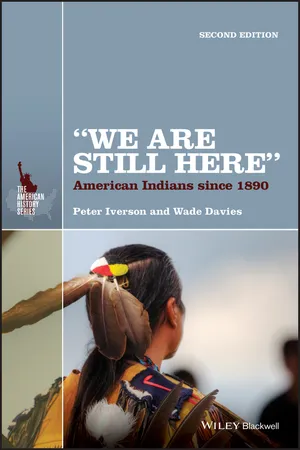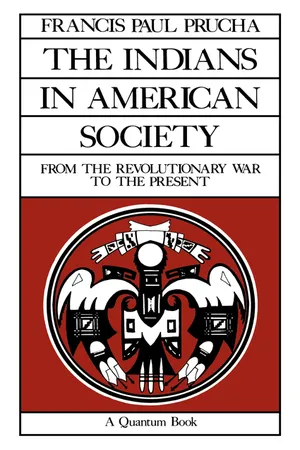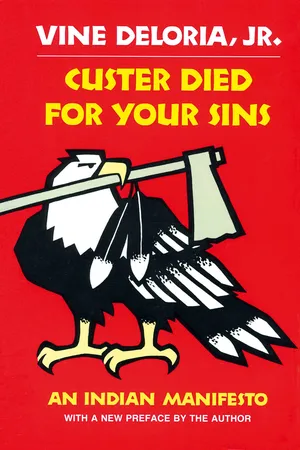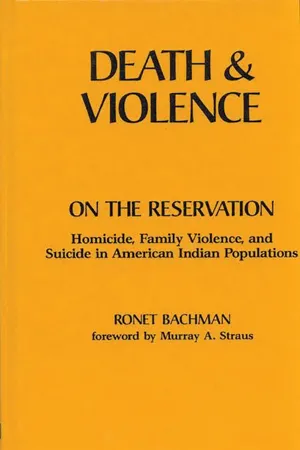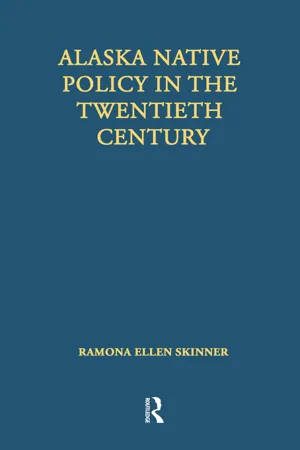History
Indian Termination Policy
The Indian Termination Policy was a US government initiative in the 1950s aimed at ending the special relationship between Native American tribes and the federal government. It sought to assimilate Native Americans into mainstream American society by terminating tribal sovereignty, relocating individuals to urban areas, and selling off reservation lands. The policy was widely criticized for its detrimental impact on Native American communities.
Written by Perlego with AI-assistance
Related key terms
1 of 5
8 Key excerpts on "Indian Termination Policy"
- Guy B. Senese(Author)
- 1991(Publication Date)
- Praeger(Publisher)
A second analysis of this development notes how the broadest outlines of policy were carved by a relatively few, elite policymakers. These policy develop- ments were surely influenced by the persistent struggle by Indian people for greater control of their affairs. Yet it is ironic that a policy of tribal self- determination was conceived and designed primarily by closely connected, unelected, policy oligarchies, the commissions and task forces whose operations so characterize the shape and formation of so much twentieth century progres- sive government Indian policy advisement. 1 Swift Ter minati on and Indian Emancipation During and after World War II there was great pressure to terminate reservation status for many tribes, and a growing emphasis on the successful assimilation of Indian people and lands into the American social and economic culture. Termination refers to the end of the responsibility of the federal government for the provision of a variety of social, educational and economic services as well as the protection of Indian lands and property held in trust for the tribes. The relationship stemmed from agreements in treaty and in exchange for lands and rights ceded to the United States or colonial territories by Indian people. The arguments that are most often given for the resurgence of an effort to assimilate and terminate after the war are based, ironically, on the success of the Indian GIs and war workers. World War II mobilized a great number of Indian adults who aided the war effort in a variety of ways. At least 25,000 Indians served in the armed forces during World War II. 1 Twenty-two thousand served in the army on the front lines; 2,000 served in the Navy, 120 in the Coast Guard, and 730 in the Marines. 2 The earliest arguments for postwar termination came from those who believed the Indian's war service earned him the right to keep or sell his land as he chose.- Claudia Haake(Author)
- 2007(Publication Date)
- Taylor & Francis(Publisher)
The effects on the terminated tribes were often disastrous. Land ownership changed fundamentally, the trust relationship was ended, state jurisdiction and state judicial authority were imposed, exemption from state taxing power was terminated, federal programs were discontinued, and—most importantly—tribal sovereignty was ended. 48 The benefits the Indians gained in return were very small, usually limited to a single payment. But, as Peter Iverson has stated, “the threat of federal withdrawal helped galvanize the beginnings of the modern Native American movement toward self-determination” and hence in some respects termination could be considered to have backfired. 49 While the program furthered urban migration that did not automatically bring about assimilation. Donald Fixico has pointed out that “urban Indians chose not to assimilate and white society did not encourage acceptance of Indians.” 50 Pan-Indianism was encouraged through the common experience of racism and other problems in the cities. Between 1953 and 1958, 109 indigenous nations or parts thereof were terminated under this policy. 51 The Termination program was brought to a halt as quickly as it had begun. In 1958 it was announced that no Indian tribe would be terminated without its consent. But it took until 1970 and the government of Richard Nixon to officially repudiate the policy of termination. Some communities like the Klamath and Menominee were later restored after petitioning Congress but others are still trying to accomplish this goal today. Another post-war policy and also yet another attempt to assimilate the Indians into the American mainstream of the 1950s and 60s was relocation. It was based on a public law commonly know as the Relocation Act, which was passed in 1956. Federal funds available for Indian programs were rapidly decreasing, and already poor services suffered even more- Theodor P Gordon(Author)
- 2018(Publication Date)
- University of Nevada Press(Publisher)
4 TERMINATION AND REVITALIZATION P UBLIC POLICIES can sometimes produce unintended results. There might be no greater example of this than the federal policies that sought to force American Indians to assimilate. These unintended results can especially be seen in the middle of the twentieth century, when Congress pursued an agenda that is now known as termination. Coupled with the attempt to assimilate native children by requiring them to attend boarding schools, termination only strengthened the resolve of native nations to retain their sovereignty. Policymakers wrongly assumed that if the federal government ceased its acknowledgment of tribal sovereignty, then it would disappear. Federal policies fomented a resurgence of tribal sovereignty that reaches into the present day, including the tribal gaming movement. This chapter examines the impacts of the termination policies and how the Cahuilla contributed to the larger movement of revitalizing sovereignty. Termination Around the middle of the twentieth century Congress began systematically repealing the Indian Reorganization Act, which had overturned the Dawes Act and encouraged limited forms of native nation self-determination. In August 1953 Congress passed House Concurrent Resolution 108 that asserted the federal government was to act “as rapidly as possible, to make the Indians. . .subject to the same laws and entitled to the same privileges and responsibilities as are applicable to other citizens. . .[and] to end their status as wards” (B132). Later that month Congress passed Public Law 280 (Pub.L. 83-280). (See chapter 5 for further discussion of the significant role Public Law 280 played in Cabazon’s case before the Supreme Court.) Public Law 280 provided six states with criminal jurisdiction on Indian lands within those states, marking the first time since Worcester v. Georgia (1832) that the federal government granted states significant authority on tribal land; it now applies in sixteen states- eBook - ePub
"We Are Still Here"
American Indians Since 1890
- Peter Iverson, Wade Davies(Authors)
- 2014(Publication Date)
- Wiley-Blackwell(Publisher)
Reader's Digest, the answer seemed simple. “Set the Indians Free!,” he entitled his article. He urged Congress to “emancipate” the Indians by removing “restrictions” that stood in their way. Free from the roadblocks imposed by federal trusteeship, Native American communities would be liberated to achieve new heights now denied them. America, he argued, should not foster segregation but integration. Others owned lands privately rather than in common. The idea of a reservation had become outmoded. Employing rhetoric and logic eerily comparable to the language and reasoning of Indian policy reformers during the late nineteenth century, Armstrong called for a new era in Indian affairs. The Indians had proved their mettle during the war; they were ready to become full-fledged Americans. However, this effort to terminate federal trust responsibility spelled potential disaster for Indian America.Two interrelated developments marked the period from war's end until the beginning of the 1960s. The first helped encourage the second. The drive toward terminating federal trust responsibility for Indians caused immediate harm and sometimes lasting damage to certain Indian communities. However, the threat of federal withdrawal helped galvanize the beginnings of the modern Native American movement toward self-determination. Indian individuals and groups responded forcefully to reaffirm their rights and to find new means to realize them. Federal policies, then, did have negative consequences, yet Indians during this time also constructed the foundation for a movement in the 1960s that, like the African-American civil rights movement, had its origins in the prior decade.Congress officially launched termination by passing Concurrent Resolution 108 in 1953, but the resolution followed years of discussion and debate. The goals of withdrawing federal services from and federal protection of Indian communities fit well with the more conservative postwar mood in the United States. Republicans were more likely to favor turning Indian affairs over to the states, but momentum for termination developed during the Truman administration. Critics called for “liberation” of the Indians from the shackles of federal paternalism. They perceived reservations as antiquated relics of a bygone age. If reservations could be eliminated, their acreage fully divided into property, and individual Indians freed from the restraint of federal bureaucracy, they professed, Indians would be better able to reach their full potential.Not all Native Americans disagreed with this prescription. Some fully subscribed to the idea of assimilation, while others bitterly resented the kind of control BIA officials still appeared to maintain over tribal councils. With the postwar economic boom centered in urban America, more than a few Indians saw the cities as places where opportunity beckoned. Yet most Native Americans wanted relocation to urban areas to be voluntary rather than required. They recognized that the young could migrate to the city more easily and effectively than could older people. Indians knew that relocation could sever connections to the land and relationships among extended family members. They resented the heavy-handed tactics and simplistic thinking embraced by congressional proponents of “reform.” In the process of resisting an imposed direction, Native persons increasingly began to chart a direction of their own, one that emphasized pride in tribal and Indian identity and a conviction that Indians were entitled to a wide range of rights. - eBook - PDF
The Indians in American Society
From the Revolutionary War to the Present
- Francis Paul Prucha(Author)
- 1985(Publication Date)
- University of California Press(Publisher)
Thus there came together in the termination policy of the 1950s a good many threads of history, not only from the as-similationist era of the nineteenth and early twentieth Indian Rights 69 centuries but from the reform movement of the 1920s and 1930s as well. 15 Although there was a kind of inner dynamism within the movement that came from a firmly held philosophical position that the Indians must be integrated into white society and not be allowed or encouraged to remain a segregated segment within the nation, the termination era coincided with and was strengthened by the political and economic conditions of the decade. Postwar economy moves called for reduction of government spending. The period was a time of economic growth, and the tying up of Indian lands and other resources in tribal enclaves went against the prevailing mood. The Cold War between the United States and the Soviet Union placed particular value on national unity and conformity, and special groups, especially if they emphasized communal values, were considered out of line. And as the growing popula-tion pushed beyond the capabilities of the reservations to support it, a movement to urban centers, with consequent assimilationist pressures, coincided with the termination actions of the government. The leading promoter of termination was Senator Ar-thur V. Watkins of Utah, who looked upon the Indian New Deal as a serious mistake. Watkins wrote in 1957: Unfortunately, the major and continuing Congressional movement toward full freedom was delayed for a time by the Indian Reorganization Act of 1934, the Wheeler-Howard Act. Amid the deep social concern of the de-pression years, Congress deviated from its accustomed policy under the concept of promoting the general Indian welfare. In the post-depression years Congress—realiz-ing this change of policy—sought to return to the historic 70 Indian Rights principles of much earlier decades. - eBook - ePub
- Vine Deloria(Author)
- 2018(Publication Date)
- Scribner(Publisher)
THE DISASTROUS POLICY OF TERMINATIONPEOPLE OFTEN FEEL guilty about their ancestors killing all those Indians years ago. But they shouldn’t feel guilty about the distant past. Just the last two decades have seen a more devious but hardly less successful war waged against Indian communities. In the old days blankets infected with smallpox were given to the tribes in an effort to decimate them. In the past they were systematically hunted down and destroyed. Were an individual citizen to do this it would be classified as cold-blooded murder. When it was done by the U.S. Army it was an “Indian war.” But during the past twenty years federal medical services have been denied various tribes, resulting in tremendous increase in disease.The Congressional policy of termination, advanced in 1954 and pushed vigorously for nearly a decade, was a combination of the old systematic hunt and the deprivation of services. Yet this policy was not conceived as a policy of murder. Rather it was thought that it would provide that elusive “answer” to the Indian problem. And when it proved to be no answer at all, Congress continued its policy, having found a new weapon in the ancient battle for Indian land.The roots of termination extend backward in time to the early years of the Roosevelt administration. The New Deal ushered in a new program for the Indian people. The Meriam Report of 1928 had shown that Indian tribes were in a desperate situation. There had been no progress of any kind on the reservations since they were set up. The people were in the final stages of demise.Pressures for reform coincided with the election of Roosevelt, who appointed John Collier as Commissioner of Indian Affairs. Collier was a well-known anthropologist of liberal persuasion. He quickly pushed the Wheeler-Howard Act through Congress in 1934 and gave the reservations their first taste of self-government in nearly half a century. - eBook - PDF
Death and Violence on the Reservation
Homicide, Family Violence, and Suicide in American Indian Populations
- Ronet Bachman(Author)
- 1992(Publication Date)
- Praeger(Publisher)
Policy Implications 131 in life. I think this is what education means. Some people say that a man without education might as well be dead. I say, a man without identity—if a man doesn't know who he is—he might as well be dead. Inconsistent policies imposed by the U.S. government have created a virtual wasteland as far as American Indian identities are concerned. 6 During the past 150 years, the policy of the U.S. government toward American Indians can be characterized as having five distinct periods: (1) separation, during which the prime objective was to remove Indians from the land that Whites desired and draw boundaries between the two peoples; (2) coercive assimilation, during which Whites sought to replace Indian culture with the dominant White culture and to help Indians become self-sufficient farmers and artisans, under conditions deemed suitable by Whites; (3) tribal restoration, phase I, during which Whites reversed previous policy and encouraged Indians to maintain their cor- porate tribal existence if they chose to do so; (4) termination, during which the objective was to break off all relationships of protection and assistance with the federal government; and (5) tribal restoration, phase II, during which tribal corporate adaptation to American society was again encouraged and cultural choice was reaffirmed. This inconsistency has perhaps been one of the leading contributors to the culture conflict that many American Indians perceive today. Consis- tent policy is needed whereby every American Indian is given the oppor- tunity to explore his or her heritage and culture. There are several ways to encourage this development. Aggressive educational efforts that encourage cultural choice must be implemented. Steps should be taken, for example, to include Indian languages in school textbooks, teach Indian languages in local Indian schools, and revive Indian religions. - eBook - ePub
- Ramona Ellen Skinner(Author)
- 2019(Publication Date)
- Routledge(Publisher)
Like nineteenth-century Indian policy, twentieth-century Indian policy also focused on a solution to the “Indian problem.” This required federal cooperation with Native peoples which resulted in an enormous federal financial and administrative entanglement. Once the policy makers solved the “Indian problem,” the federal government would no longer be in the business of providing support for Indian programs and services or be responsible for administrating Indian trust lands or supervising Indian affairs. In effect, resolving the “Indian problem” entails getting out of the “Indian business,” demanding that Congress terminate the trust relationship.NOTES
1. Francis Jennings, The Invasion of America (New York: W.W. Norton and Company, 1975), 15.2. Ibid., 15, 61; Francis Jennings, The Founders of America: From the Earliest Migrations to the Present (New York: W. W. Norton and Company, 1993), 83.3. For a comprehensive treatment of the Indian Trade and Intercourse Acts, see Francis Paul Prucha, American Indian Policy in the Formative Years: The Indian Trade and Intercourse Acts, 1790–1834 (Cambridge: Harvard University Press, 1962).4. Ibid., 2; Charles F. Wilkinson and Eric R. Biggs, “Evolution of the Termination Policy,” American Indian Law Review 5 (Number 1, 1977): 141.5. S. Lyman Tyler, A History of Indian Policy (Washington, D.C.: Bureau of Indian Affairs, 1973), 45.6. Ibid., 46.7. R. David Edmunds, “National Expansion from the Indian Perspective,” in Indians in American History, Frederick E. Hoxie, ed. (Arlington Heights, Ill.: Harlan Davidson, Inc., 1988), 174.8. Ibid.9. Felix S. Cohen, “Original Indian Title,” in The Legal Conscience-Selected Papers of Felix S. Cohen, Lucy Kramer Cohen, ed. (Hamden, Conn.: Archon Books, 1970), 273.10. Rennard Strickland and Charles F. Wilkinson, eds., Felix S. Cohen’s Handbook of Federal Indian Law (Charlottesville, Va.: Michie Bobbs-Merril, 1982), 473.11. Frank Pommersheim, Braid of Feathers: American Indian Law and Contemporary Tribal Life (Berkeley: University of California Press, 1995), 40-41.12. Johnson v. McIntosh 21 US 543 (1823).13. Ibid.14. Charles F. Wilkinson, American Indians, Time, and the Law: Native Societies in a Modern Constitutional Democracy (New Haven, Conn.: Yale University Press, 1987), 40.15. Robert A. Williams, Jr., The American Indian in Western Legal Thought: The Discourse of Conquest (Oxford: Oxford University Press, 1990), 315.16. Ibid., 317.17. Cherokee Nation v. Georgia
Index pages curate the most relevant extracts from our library of academic textbooks. They’ve been created using an in-house natural language model (NLM), each adding context and meaning to key research topics.
